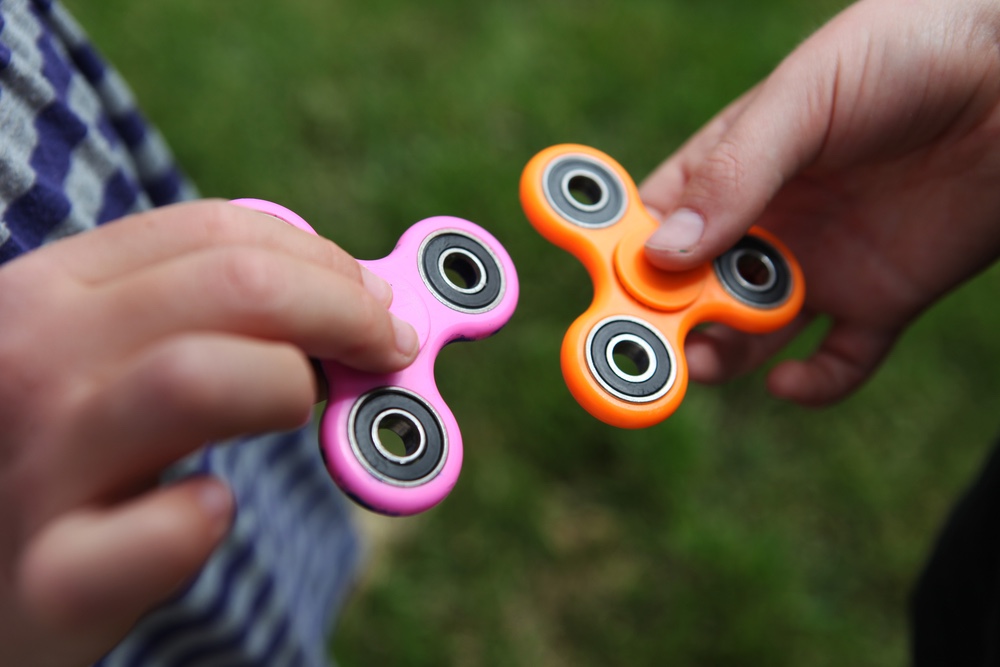
Fidget spinners may be fun toys, but there is no science behind claims that they help kids with attention and focus, according to a new review article.
The review, which was published July 7 in the journal Current Opinion in Pediatrics, found that no research had specifically focused on the impact of these hot new toys on thinking, attention or recall. Furthermore, there are zero peer-reviwed studies on any aspect of fidget spinners, the researchers found. Without that research, claims made by manufacturers about such links are baseless.
"There's no science behind the idea that they increase attention," said study co-author Dr. Ruth Milanaik, director of the neonatal follow-up program at Cohen Children's Medical Center of New York. "We have to view it as what it is: It's a toy, a fun toy." [How Fidget Spinners Work: It's All About the Physics]
Claims of attention
Some of the companies marketing fidget spinners, or small, ball-bearing-filled plastic toys that spin when you rotate them, claim the toys can increase attention for those with attention deficit hyperactivity disorder (ADHD) or calm symptoms of autism or anxiety. For instance, the Cppslee Hands Fidget Spinner sold on Amazon claims the toys are great for anxiety, focusing, ADHD and autism, in addition to quitting bad habits and staying awake. [Why Fidget Spinners Are So Hot (And Where to Buy Them)]
To see whether any of these marketing claims had basis in fact, Milanaik and her colleagues looked through the available literature to find studies on fidget spinners. It turned out, there is no scientific evidence supporting these marketing claims, Milanaik and her colleagues reported in the current review paper. That could be because the gadgets don't benefit a kid's focus, or because nobody has done a substantial enough study on the claims.
Fidgeting benefits
Some limited studies do show benefits to fidgeting in children with ADHD. For instance, in a small study published in 1995 in the Journal of Child Psychology and Psychiatry found that boys with ADHD who can squirm and fidget instead of sitting still show greater attention to a task; however, the same benefit was not shown for children who did not have ADHD. A 2016 study monitored children's activity via an ankle bracelet and found that children with ADHD tended to do better on attention tasks when they could fidget.
When it comes to fidget toys, one study found that children who used stress balls, which are squishy foam balls, reported better attention in class and improved performance. Still other work shows that fidgeting and movement releases norepinephrine and dopamine, the same brain chemicals that are stimulated by ADHD medications. In addition, some evidence suggests that certain types of self-regulation toys can incentivize children with autism to complete tasks at school, the study found.
Sign up for the Live Science daily newsletter now
Get the world’s most fascinating discoveries delivered straight to your inbox.
No evidence of benefits
However, there were no studies that specifically looked at the effects of fidget spinners on attention, the review found. And no two distraction-aid toys are alike, so extrapolating from studies that used different toys can be dicey.
"The concept of using therapy putty might be different from using a squish ball might be different from the concept of using a fidget spinner," Milanaik told Live Science.
To measure attention, researchers often give children simple tasks, such as adding or subtracting small numbers, and then count how many they complete (and complete correctly) either with or without the toys, Milanaik said. Studies may also assess listening and recall by asking people to repeat back a series of numbers either with or without the toys, she added. Milanaik's group is currently assessing the role of "therapy putty" on attention, though they likely won't have results for several months.
Limiting use in schools
Parents who believe fidget spinners have attentional benefits for their kids should feel free to experiment with their child while they're at home, doing homework or reading a book, Milanaik said.
But letting them enter the classroom is a different story. Most schools ban toys from classrooms, but some still allow children to bring in fidget spinners to address their sensory issues, the study found. But with no scientific evidence of their benefits, fidget spinners in the classroom could do more harm than good, the study noted.
For one, some fidget spinners come apart easily, and the ball bearings inside them can be choking hazards, she said.
Beyond that, one child's attention aid could be another child's annoying distraction, Milanaik said.
For instance, in research meetings, Milanaik has found that fidget spinners can distract group members.
"They make a spinning noise, we find it distracting when we have to work in a group — but we all like to use them," Milanaik said.
And of course, any toy that enters the classroom could be the source of squabbling, bartering or other distracting behavior, which could undercut any potential attentional benefits, the review noted.
"A classroom is a wonderful group of children," Milanaik said. "Some things that might be great for one child might be very distracting for another."
Originally published on Live Science.

Tia is the managing editor and was previously a senior writer for Live Science. Her work has appeared in Scientific American, Wired.com and other outlets. She holds a master's degree in bioengineering from the University of Washington, a graduate certificate in science writing from UC Santa Cruz and a bachelor's degree in mechanical engineering from the University of Texas at Austin. Tia was part of a team at the Milwaukee Journal Sentinel that published the Empty Cradles series on preterm births, which won multiple awards, including the 2012 Casey Medal for Meritorious Journalism.









